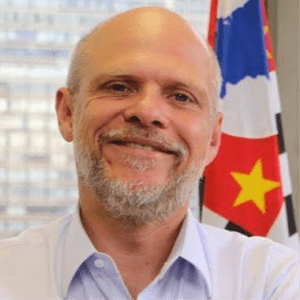17 May 2021 In Active Mobility, Blog Post, Dialogue and Networking, Global, Public Transport, Sustainable Development
Stuck in the wrong direction
Sergio Avelleda, Director of Urban Mobility, WRI Ross Center for Sustainable Cities
Brazilian cities have been avoiding an urgent debate: charging car users the cost of public infrastructure and allocating these resources for public transportation.
It is possible that sometime, with a group of friends in a bar on the weekend – when we were able to meet friends, pleasure that the responsibility will prevent until the vaccination is completed -, you have heard something like this: “I don’t use public transport in Brazil. It sucks. My maid tells me that she spends more than two hours between train and bus to get to work. No way.” And after a lot of beer, when it’s time to leave, there he is, the “critical” friend getting into his car, which weighs between 1 and 2 tons – and, at 40 km / h, considered the space needed to brake and accelerate, he can occupy up to 115 cubic meters of streets and avenues to pass through, according to a study carried out in Switzerland.
The statement that public transport in the country is bad, made by someone who does not use it, is usually based on prejudice. A similar discourse is heard about the National Health System (Sistema Único de Saúde – SUS). It is of no value to those who do not use it – while it represents a lifeline for users. SUS is not a wonder, of course, but it solves most of the public health problems in Brazil.
The main problems of urban mobility – a concept that includes, in addition to public transport, walking, bicycles, private vehicles, systems based on platforms and the distribution of goods and products – are originated, curiously, outside urban mobility itself. I always say that a city with mobility problems is like a patient with fever. Fever is not the disease, it is a sign that your body is working to keep you healthy from an infection. Thus, the cities with crowded buses and metro lines, congestion and high rates of traffic accidents are desperately signing: “We were poorly planned. Our growth was irrational. People live farther and farther away and job opportunities are increasingly concentrated… ”
The solution to these structural problems requires not only political will and the engagement of urban actors, but also a very long term. Meanwhile, urban mobility systems need to receive investments and priorities to make access to cities democratic and feasible. Without it, the city loses competitiveness and diversity, at the risk of diminishing its wealth.
The investment in public transport is one of those unanimous debates. No one nowadays, in fact, announces government plans saying that they will invest so that people can use more cars; that automobiles will benefit from new avenues and viaducts; that it is intended to remove spaces for pedestrians, cyclists (almost nonexistent) and public transport and give them to cars and motorbikes. I have read countless government projects in the past few years and I have never encountered anything like that.
However, during the execution of such plans, we see very little desire to really prioritize public transport. We do not invest the minimum necessary, we do not work to consider financing the operation of the services. It is avoided to take space from the cars for the implementation of bus lanes, which can significantly improve the efficiency of this service at an incredibly low cost. There’s no investment in technology neither the modernization of hiring private operators.
In metropolitan regions there are almost no initiatives to implement joint management, despite the abundant literature and experiences that show the countless gains in the use of metropolitan authorities. In short: we know by heart what is to be done, but we hardly do it. The question I increasingly insist on is: why isn’t there a clear debate about public transport in Brazilian cities?
There is no space in this article to exhaust the possibilities of why we don’t do the obvious, which is known, endorsed and experienced. However, some hypotheses can be cited.
I think that one of the reasons why we remain in a kind of inertia is society’s lack of awareness of the concept of externalities in mobility systems. Externality is an effect of a particular activity that affects others without affecting the activity that generates it. It can be negative, when it harms others, or positive, if it benefits them.
The individual use of a car is a strong generator of negative externalities. A car weighs between 900 kg and two tons. On average, in Brazilian cities, a car carries 1.1 passengers. That is, to move something around 80 kg, a machine that weighs up to 24 times more is used. The energy consumption to move this person, measured in megajoules, 1 is between 2.3 and 2.6 Mj / pass-km, according to data from the National Association of Public Transport. If this person decided to go by bus, it would consume between 0.6 and 0.8 Mj / pass-km. This excessive consumption of energy makes cars the great villains of urban pollution. And, to make matters worse, we must not forget that automobiles still hurt and kill thousands of people every day.
A study published by Discourse Media, conducted in Canadian cities, shows that if commuting on foot costs an individual who is walking the amount of 1 dollar, to society that trip will cost 1 cent. If the decision is to get around by bicycle, the proportion will be 1 dollar of expense for the cyclist and 8 cents for the community. If our traveler decides to go by bus and this trip costs him the same dollar, the society will pay 1 dollar and 50 cents. Did you find it expensive? Then see the cost of traveling by individual car. If our driver pays a dollar for a car trip, the whole society will pay 9 dollars and 20 cents.
Astonished? Yes, unfortunately, we do not have this debate. Society has no idea of how much it costs to move by car. For instance, if you enter the site of the city hall of São Paulo, you will easily identify the amounts paid as a subsidy for public transport. It is there, in a specific budget line. However, if you try to search for the expense of the municipal executive with individual motorized transport you will not find, not in São Paulo and, probably, neither in any other city in Brazil.
And, of course, this expense does exist and it is gigantic: it is a significant part of the expenses with the entire pavement of 17 thousand km of streets and avenues in the capital of São Paulo, traffic signs, traffic lights and engineering. It is also reflected in the financial and human cost of deaths and injuries – 60% of ICU vacancies in the country are occupied by victims of traffic accidents -, pollution, congestion, use of public space and other tangible and intangible costs . When an expense is unknown, we have the feeling that it does not exist. If it doesn’t bother society, there is no reason to discuss it. If we don’t argue, we continue, as a society, paying for it, without questioning it. On the other hand, we debate intensely whether the subsidy for public transport in São Paulo is too much or too little, if it is well spent or if it can be better applied, etc.
Many cities around the world are facing this debate. Is it fair that the whole society subsidizes the use of the private vehicle, which generates so many negative externalities? Is it correct that the private use of public roads by the automobile continues to be supported by all taxpayers, including those who do not own a car? Is it fair for the SUV driver to use the asphalt, traffic lights and park without paying while the bus passenger, from Guaianases to downtown São Paulo, has to pay 4.40 reais? London, Singapore and New York have already established vehicle user charges for the use of public infrastructure and are using these resources to expand and improve public transport.
This discussion has already been overcome on the highways. On the main roads, the cost of maintenance is borne exclusively by its users. The discourse on the elimination of tolls is no longer echoed in society. Everyone has understood that this model is much more fair. Resources that were drained from the government budget for road maintenance today can be allocated to other public services. Someone may say: I already pay the IPVA (Motor Vehicle Property Tax), but bear in mind that tax payment is not related to the use of public infrastructure. You also pay IPTU (Urban Land Tax) and don’t have access to free water, electricity, gas or internet because of that.
Why not have this discussion in the cities? Why not pass the costs of maintaining motorways to its users and transfer those resources to investments in public transport and / or to reduce the fare price, which would benefit many more people, amplify and democratize access, improve the environment and decrease the number of deaths and injuries in traffic.

Sergio Avelleda
Before joining WRI, Sergio was the Secretary of Mobility and Transport in São Paulo, Brazil, where he was responsible for managing traffic challenges and the most extensive bus system in the world. He led more than five thousand people and spearheaded city implementation of Vision Zero programs to reduce traffic fatalities. Sergio was additionally in charge of taxi regulation and transport mobile apps, as well as the management of the freight transport system.

Jill Duggan
Jill Duggan is the Executive Director of EDF Europe. She oversees EDF Europe, drawing on her extensive international career in climate, environment and energy policy. She is developing EDF's strategic vision for Europe, building partnerships with key EU stakeholders, drawing on EDF’s strong science and economics base to provide cross cutting resilient solutions to the 21st century environmental challenges.